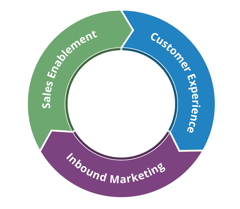Sales and marketing alignment is an issue that organizations have been facing for years. The marketing department's primary focus is generating leads (among many other things), and the sales team is responsible for turning those leads into customers. In a perfect world, marketing and sales work in tandem, aligning their roles and goals to ensure that ROI becomes the responsibility of the whole organization.
However, in reality, it doesn't always quite go as planned. A primary complaint of the sales team is that they don't think the marketing team is bringing in enough leads to fill their pipeline (or enough quality leads), and the marketing team doesn't think the sales team is working the leads hard enough.
There must be a better way to align your sales and marketing teams. There is, and it's called "smarketing." Smarketing is the alignment between your sales and marketing teams created through frequent and direct communication between the two groups. The goal is to have measurable goals that each team agrees to hit, so there's mutual accountability instead of the inevitable "blame game."
Here are four strategies to better align your sales and marketing teams:
1. Communicate
Clear and direct communication is the first step to getting your sales and marketing teams to collaborate efficiently and effectively. For the relationship to be successful between both teams, it is essential to share processes, resources, and best practices from the start. Getting the teams to collaborate at first may not be easy, but once they do, it will be the key to long-lasting success.
Here's an idea we've seen work effectively in the past: Let your marketing team sit in on sales calls. In addition, have your sales staff sit in on marketing meetings when new product features or new services are being discussed, roll out strategies, and campaign discussions, so they understand the full scope of the marketing plan. Then, to keep the momentum, schedule weekly meetings where everyone can discuss the quality of the leads that have been generated, track the combined team's progress, and celebrate the "wins." Weekly may seem like a lot, but it's imperative to discuss lead quality and the follow-up strategy on a frequent and regular basis to ensure you are on track toward your mutual revenue goal.
2. Utilize Data
Facts and figures are powerful tools when it comes to overcoming frustration. It's easy to blame others when the data and facts aren't available. So utilize data whenever you can to hold your sales and marketing teams accountable to meet the measurable goals you have set for both.
Ensure your marketing team measures the volume and quality of the leads they generate. Make sure your sales team is working leads at an impressively steady rate. Measure the numbers and hold both groups accountable for meeting the predetermined metrics. Then share the data with both teams so everyone is held accountable and both teams can work together to help the other succeed.
3. Develop a Service Level Agreement (SLA)
At times, it might seem like you need a miracle to help bring peace to the relationship between your sales and marketing teams. But in reality, all you might need is a Service Level Agreement (SLA). A Service Level Agreement lays out what each team expects each month. The marketing team commits to delivering a certain number of quality leads, and the sales team commits to working on a certain number of leads that they are delivered. It seems simple, right? If both teams are living up to their end of the agreement, at the end of the month, there can be no complaining or finger-pointing if everyone has delivered on their agreed-upon goals.
4. Utilize Software to Streamline the Process
How can the marketing team know what the sales team is doing, and vice versa, if they are operating with different information? That's why you should consider having your sales and marketing teams share the same software system. A few software systems allow you to use one platform to manage your sales and marketing, so real-time data is transmitted between the two teams. If you use a system that doesn't have a marketing automation platform built in, or a CRM platform built in, be sure you can sync and integrate those two systems at a minimum. This is a must! Sharing the same system, like HubSpot's marketing platform and the HubSpot CRM, allows both teams to understand better what is happening with their leads, from when they are identified as a prospect to the close of the sale beyond.
Now that you have four proven strategies to align your sales and marketing teams, it's time to put these strategies in place and get them to work in perfect (and profitable) harmony. If you're interested in learning more about how to align your sales and marketing teams, we invite you to schedule a 30-minute marketing & sales alignment consultation with a member of our team.


__Square.png?width=250&height=250&name=Marketing_Hub_(1)__Square.png)




.png?width=250&name=diamond-badge-color%20(1).png)
